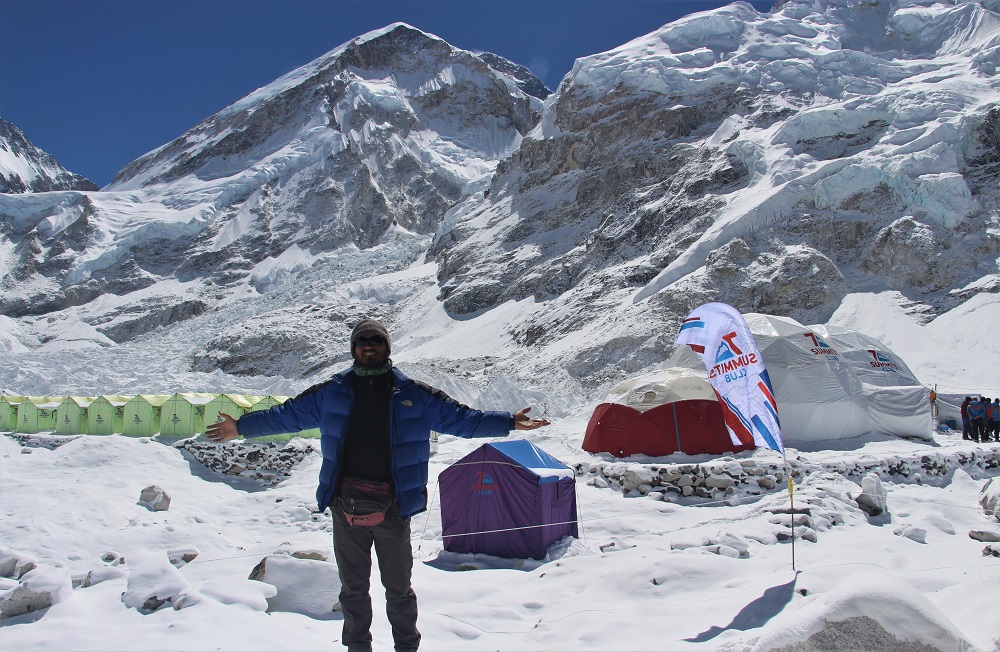Everest Base Camp Trek acclimatization
Acclimatization is a crucial aspect of the Everest Base Camp Trek, playing a pivotal role in ensuring a safe and successful journey to one of the world’s most renowned trekking destinations. As trekkers ascend to higher altitudes, the body must adapt to the reduced oxygen levels to avoid altitude sickness and other related health issues. The process of acclimatization involves several strategies designed to help the body adjust gradually to the lower oxygen levels encountered at high elevations.
The trek typically follows a carefully planned itinerary that includes acclimatization days built into the schedule. These days are strategically placed at key elevations along the route, allowing trekkers to spend additional time at intermediate altitudes without ascending further. This approach helps the body to adjust to the lower oxygen levels before making further progress. Mount Everest Base Camp For instance, after reaching a certain altitude, trekkers might spend an extra day at that elevation or undertake short, additional hikes to higher altitudes during the day but return to the lower altitude to sleep. This “climb high, sleep low” strategy is a well-regarded method for promoting effective acclimatization.
Another important aspect of acclimatization is maintaining a slow and steady pace throughout the trek. Rapid ascents increase the risk of altitude sickness, as the body needs time to adapt to the changing conditions. Trekking at a moderate pace and allowing frequent rest breaks helps to prevent overexertion and supports the acclimatization process. Staying well-hydrated is also essential; drinking plenty of water helps to maintain optimal physiological function and supports the body’s adaptation to higher altitudes.
Monitoring for symptoms of altitude sickness is a critical part of acclimatization. Symptoms such as headaches, nausea, dizziness, and shortness of breath are common indicators that the body is struggling to adjust. It’s important to recognize these symptoms early and take appropriate actions, which may include descending to a lower altitude or seeking medical attention if symptoms persist or worsen.
Overall, successful acclimatization on the Everest Base Camp Trek involves a combination of gradual ascent, strategic rest days, proper hydration, and vigilant monitoring of one’s health. By adhering to these principles, trekkers can reduce the risk of altitude sickness and enhance their overall trekking experience. The goal is not only to reach Everest Base Camp but to enjoy the journey while adapting safely to the stunning but challenging environment of the Himalayas.
Introduction to Acclimatization
Acclimatization is a fundamental process in high-altitude trekking that allows the body to gradually adjust to reduced oxygen levels as elevation increases. For trekkers aiming to reach Everest Base Camp Trek Itinerary, acclimatization becomes critical due to the extreme altitude of the trek, which reaches up to 5,364 meters (17,598 feet). The body’s ability to adapt to these conditions is not immediate; it requires careful management of ascent rates and rest periods to prevent altitude sickness and ensure a safe journey. This process involves several strategies that help the body cope with the lower oxygen levels, including gradual ascent, adequate hydration, and proper rest. Understanding and implementing effective acclimatization techniques are essential for a successful trek, as they mitigate the risks associated with high-altitude environments and enhance the overall trekking experience.
Importance of Acclimatization in High Altitude Treks
Acclimatization is crucial in high-altitude treks because it helps prevent altitude sickness, a common condition that can affect trekkers when ascending too quickly. At high altitudes, the air contains less oxygen, making it challenging for the body to function normally. Without proper acclimatization, trekkers may experience symptoms such as headaches, nausea, and dizziness, which can escalate into more severe conditions like High Altitude Pulmonary Edema (HAPE) or High Altitude Cerebral Edema (HACE). By allowing the body to adjust gradually to the decreased oxygen levels, acclimatization reduces these risks and supports overall health and performance. This process involves ascending slowly, incorporating rest days, and ensuring proper hydration. Effective acclimatization not only enhances safety but also improves the chances of successfully reaching the trekking destination and fully enjoying the high-altitude adventure.
Symptoms of Acute Mountain Sickness (AMS)
Acute Mountain Sickness (AMS) is a common and potentially serious condition that occurs when trekkers ascend to high altitudes without adequate acclimatization. Symptoms of AMS typically begin to manifest above 2,500 meters (8,200 feet) and can include headaches, nausea, vomiting, dizziness, fatigue, and shortness of breath. These symptoms result from the body’s struggle to adapt to the lower oxygen levels at high elevations. AMS can range from mild to severe, with more serious forms potentially leading to High Altitude Pulmonary Edema (HAPE) or High Altitude Cerebral Edema (HACE). Recognizing the early signs of AMS is crucial for prompt intervention. If symptoms are severe or persistent, it is essential to descend to a lower altitude and seek medical attention. Early detection and treatment are key to preventing the progression of AMS and ensuring a safe trekking experience.
Acclimatization Techniques and Strategies
Effective acclimatization techniques are essential for a safe and enjoyable high-altitude trek. One key strategy is to ascend gradually, allowing the body time to adjust to decreasing oxygen levels. This often involves a steady increase in altitude with scheduled rest days at intermediate elevations to facilitate acclimatization. Another important technique is the “climb high, sleep low” approach, where trekkers hike to higher altitudes during the day but return to a lower elevation to sleep. This method helps stimulate the production of red blood cells and improves oxygen delivery to tissues. Staying well-hydrated is also critical, as proper fluid intake supports bodily functions and enhances acclimatization. Trekking at a moderate pace, avoiding overexertion, and paying close attention to symptoms of altitude sickness are crucial for effective acclimatization. Implementing these strategies helps reduce the risk of altitude-related illnesses and contributes to a more successful trekking experience.
The Role of Elevation Gain
EBC Trek Elevation gain plays a significant role in the acclimatization process during high-altitude treks. As trekkers ascend to higher altitudes, the amount of oxygen in the air decreases, placing additional stress on the body. The rate at which elevation is gained directly impacts how well the body can adapt. Rapid ascents can overwhelm the body’s ability to acclimatize, increasing the risk of altitude sickness. To mitigate this, a gradual ascent is recommended, with incremental elevation gains that allow the body to adjust progressively. Incorporating acclimatization days into the trekking itinerary provides crucial time for the body to adapt to higher elevations before continuing the ascent. Understanding and managing elevation gain is essential for preventing altitude-related health issues and ensuring a safer and more enjoyable trekking experience. Proper elevation management helps the body acclimate effectively, reducing the risk of severe altitude sickness and enhancing overall trekking success.
Recommended Itinerary for Acclimatization
A well-planned itinerary is crucial for effective acclimatization during the Everest Base Camp Trek. The recommended itinerary typically includes several days dedicated to gradual ascent and acclimatization, which helps the body adjust to increasing altitudes and reduces the risk of altitude sickness. A common itinerary involves trekking up to key points and then returning to lower altitudes for overnight stays to allow for proper acclimatization. For example, a popular route includes ascending from Lukla to Namche Bazaar, where trekkers spend an extra day for acclimatization before continuing. From Namche, the trek moves to Tengboche and then to Dingboche, where additional acclimatization days are scheduled. During these days, trekkers might take short hikes to higher altitudes, such as to the Everest Viewpoint or Nangkartshang Peak, and return to their lodgings at lower altitudes to sleep. This approach of “climb high, sleep low” helps stimulate the body’s acclimatization processes and minimizes the risk of altitude sickness. The gradual increase in elevation combined with planned rest days ensures that trekkers are better prepared for the higher altitudes they will encounter as they continue towards Everest Base Camp.
Hydration and Nutrition for Acclimatization
Hydration and nutrition are critical components of effective acclimatization during the Everest Base Camp Trek. Proper hydration supports the body’s physiological functions and helps in the adaptation to high-altitude conditions. Trekkers should aim to drink at least 3 to 4 liters of water daily to stay well-hydrated, as dehydration can exacerbate symptoms of altitude sickness. Additionally, incorporating electrolyte-rich beverages can help maintain fluid balance. Nutrition also plays a significant role in acclimatization. A balanced diet that includes carbohydrates, proteins, and fats provides the necessary energy and supports overall health. High-carbohydrate foods are particularly beneficial as they help maintain energy levels and enhance oxygen delivery to tissues. Foods like pasta, rice, and oatmeal are commonly available on the trek and should be included in daily meals. Adequate nutrition and hydration, combined with a gradual ascent, help optimize the body’s ability to acclimate to high altitudes and improve trekking performance.
Rest Days: Importance and Benefits
Rest days are a vital part of the acclimatization process during the Everest Base Camp Trek Map, providing essential breaks that allow the body to adapt to higher altitudes. These days are strategically placed in the itinerary to help prevent altitude sickness and support the acclimatization process. During rest days, trekkers remain at the same elevation but can engage in short, low-intensity hikes to higher altitudes and then return to their lodging for sleep. This practice of “climb high, sleep low” stimulates the production of red blood cells and enhances the body’s ability to cope with decreased oxygen levels. Rest days also give trekkers a chance to recover from the physical exertion of trekking and adapt to the altitude without the added strain of continuous ascent. Proper rest contributes to overall health, reduces fatigue, and improves the likelihood of reaching Everest Base Camp without serious altitude-related issues. Incorporating adequate rest days into the trekking itinerary is essential for a safe and successful high-altitude adventure.
Medications for AMS Prevention
Medications can play a crucial role in preventing and managing Acute Mountain Sickness (AMS) during the Everest Base Camp Trek. One commonly used medication is Diamox (acetazolamide), which helps accelerate the acclimatization process by increasing breathing rate and improving oxygen uptake. Taking Diamox as a preventive measure, usually starting a day before ascent and continuing for a few days, can significantly reduce the risk of AMS. It is important to consult with a healthcare professional before starting any medication, as they can provide guidance on proper dosage and potential side effects. Additionally, over-the-counter medications such as ibuprofen can help alleviate mild symptoms of altitude sickness like headaches. However, medications should not replace proper acclimatization techniques, such as gradual ascent and hydration. Using medications in conjunction with these strategies provides a comprehensive approach to preventing AMS and ensuring a safer trekking experience. Always carry necessary medications and have a plan for their use, but prioritize acclimatization and listen to your body’s signals.
Understanding Your Body’s Response to Altitude
Understanding your body’s response to altitude is essential for a safe and successful trek to Everest Base Camp. As you ascend to higher elevations, the amount of oxygen in the air decreases, leading to a range of physiological changes. Initially, you may experience symptoms such as shortness of breath, increased heart rate, and fatigue as your body adjusts to the lower oxygen levels. It’s crucial to monitor these symptoms and differentiate between normal acclimatization processes and signs of altitude sickness. Each individual’s response to altitude can vary, with some people acclimating more quickly than others. Paying attention to how your body reacts, such as changes in energy levels, sleep patterns, and overall well-being, helps in making informed decisions about pace and ascent. If you notice persistent symptoms or severe discomfort, it’s important to take action, such as descending to a lower altitude or seeking medical attention. Being aware of your body’s signals and understanding the normal acclimatization process supports a safer and more enjoyable high-altitude trekking experience.
When to Descend: Recognizing Danger Signs
Recognizing when to descend during the Everest Base Camp Trekking is crucial for preventing severe altitude-related health issues. While some symptoms of altitude sickness, such as mild headaches or nausea, are common and manageable, they can escalate into more serious conditions if not addressed promptly. Key danger signs that indicate the need to descend include severe headaches that don’t respond to medication, persistent nausea or vomiting, confusion, difficulty breathing, and extreme fatigue. Additionally, symptoms such as coughing up pink or frothy sputum, which can indicate High Altitude Pulmonary Edema (HAPE), or loss of coordination and impaired consciousness, which are signs of High Altitude Cerebral Edema (HACE), require immediate descent and medical attention. Trekkers should monitor their own health and that of their companions closely, and be prepared to act quickly if symptoms worsen. Descending to a lower altitude is the most effective treatment for serious altitude sickness and is often the only way to prevent further complications. Ensuring that the trek includes contingency plans for emergency descents is an important part of trek planning and safety.
Mental Preparation for High Altitudes
Mental preparation is as crucial as physical readiness for a successful Everest Base Camp Trek. High-altitude trekking poses not only physical challenges but also psychological ones, including the stress of unpredictable weather, physical discomfort, and extended periods away from home. Preparing mentally involves setting realistic expectations and being ready for the possibility of discomfort and fatigue. Developing a positive attitude and resilience can significantly impact how well you handle the mental strain of the trek. Visualization techniques, where you imagine successfully completing the trek and overcoming challenges, can enhance confidence and motivation. Additionally, being mentally prepared for isolation and limited communication can help mitigate feelings of loneliness or anxiety. Understanding that altitude affects everyone differently and that adjustments may be necessary can also reduce stress. Maintaining a flexible mindset and focusing on the journey’s rewards rather than solely on reaching the destination helps in coping with the mental demands of high-altitude trekking.
Acclimatization Myths and Facts
Acclimatization is surrounded by several myths and misconceptions that can impact trekkers’ understanding and preparedness for high-altitude treks. One common myth is that everyone can acclimatize at the same rate; however, acclimatization rates vary widely among individuals due to genetic factors, physical fitness, and previous altitude experience. Another myth is that drinking alcohol can aid acclimatization, whereas in reality, alcohol can exacerbate dehydration and altitude sickness. Some believe that faster ascents are acceptable if they are physically fit, but rapid ascents increase the risk of altitude sickness regardless of fitness level. Additionally, it is a misconception that altitude sickness only affects the inexperienced; even seasoned trekkers can experience symptoms. Facts about acclimatization emphasize the importance of gradual ascent, adequate hydration, and rest days. Understanding and debunking these myths helps trekkers adopt effective acclimatization strategies and better prepare for the challenges of high-altitude trekking.
Case Studies: Successful Acclimatization Stories
Examining case studies of successful acclimatization during high-altitude treks provides valuable insights into effective strategies and practices. For instance, a common story involves trekkers who meticulously followed a gradual ascent plan, incorporating extra acclimatization days and adhering to the “climb high, sleep low” principle. These trekkers often shared that their adherence to a slow and steady pace, combined with proper hydration and balanced nutrition, played a key role in their success. Another case study highlights the importance of recognizing early symptoms of altitude sickness and taking proactive measures, such as descending or resting, to prevent escalation. These stories often emphasize the critical role of mental preparation and flexibility, as trekkers who maintained a positive attitude and were prepared for unexpected changes were better able to handle the challenges of high altitudes. Learning from these successful acclimatization experiences provides practical examples and motivation for future trekkers, reinforcing the importance of careful planning and adaptation.
Conclusion and Final Tips
In conclusion, acclimatization is a critical aspect of a successful Everest Base Camp Trek and involves a combination of gradual ascent, proper hydration, nutrition, and mental preparation. Recognizing when to descend in response to serious altitude sickness symptoms is crucial for safety. Addressing mental preparation helps in managing the psychological demands of high-altitude trekking. Understanding and debunking common acclimatization myths ensures that trekkers employ effective strategies. Case studies of successful acclimatization provide practical insights and motivation. For a safe and rewarding trek, follow a carefully planned itinerary that includes acclimatization days, stay hydrated, eat well, monitor your health closely, and be prepared mentally and physically for the challenges ahead. Embrace the journey with an informed approach and flexibility, ensuring that your adventure to Everest Base Camp is both enjoyable and successful.
Keep an eye for more news & updates on Ty-Tribune!






